Benefactors
THE NOVI SAD CHRONICLE OF MARIJA TRANDAFIL (1814-1883), THE GREATEST SERBIAN BENEFACTOR
Oblivion Swallows Those Who Forget
She has inherited and, with a lot of effort, multiplied her enormous wealth. She owned ”half of Novi Sad”. She was hungry and poor only for a day. Without ever forgetting that day, she endowed her entire property to others; those who she thought needed it the most. She has helped the towns poorest, children, girls with no dowry, widows, the church, national institutions, hospitals… She rests in the tomb of St. Nicolas church, with her husband and children. No one holds commemoration services for her any more
By: Tatjana Marković
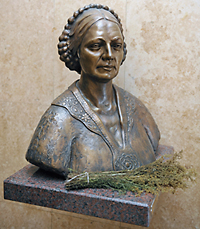 In the very heart of Novi Sad, at the saloon of a bourgeoisie home at Main Street, Miss Marija Taranfil was sitting by the window, watching the passers-by with her absent and fading look. Strict and upright, she mechanically moved her knitting needles, which were, almost by themselves, knitting two socks at the same time – one in another. If someone would check the socks of ladies at the city saloons, claimed Marija Trandafil, it would show that half of the ”nobles” had ripped heels. So if cards can be fashionable amongst women, then I guess whole socks can too. In the very heart of Novi Sad, at the saloon of a bourgeoisie home at Main Street, Miss Marija Taranfil was sitting by the window, watching the passers-by with her absent and fading look. Strict and upright, she mechanically moved her knitting needles, which were, almost by themselves, knitting two socks at the same time – one in another. If someone would check the socks of ladies at the city saloons, claimed Marija Trandafil, it would show that half of the ”nobles” had ripped heels. So if cards can be fashionable amongst women, then I guess whole socks can too.
That’s how it was done by Marija Trandafil, the greatest Serbian benefactor and endower of all times.
She was born around 1814 (some documents say 1816) in the Popović family in the downtown of Novi Sad, in a house known as ”The house at the icon”. At the façade of the building, high up the stories, there was (and is so today) a skilfully made icon of Holy Apostles Peter and Paul. These apostles will follow her during her life like an omen.
The Novi Sad newspapers Javor from 1883 published Marija’s short biography, which states:
 ”Her father was Ćira Popović, furrier, who also worked with food trade. Once he was unloading corn in Djur, when he fell ill and died at the age of 27. In Djur he was buried. Her father married twice. He first married Tajčić from Oseka, Marija’s mother, and then got married in the family Kritovča, from Ruma...” ”Her father was Ćira Popović, furrier, who also worked with food trade. Once he was unloading corn in Djur, when he fell ill and died at the age of 27. In Djur he was buried. Her father married twice. He first married Tajčić from Oseka, Marija’s mother, and then got married in the family Kritovča, from Ruma...”
As she lost her parents very early, she became protégé of her cousins, a rich trading family of Hadži Kira Nikolić from Oseka. It was common at that time for girls from rich families to be educated at private schools, where they were taught literacy from the Bible, mathematics, handicrafts, dancing and a bit of entertaining. It is well known that Marija was literate and that she knew trading transactions well, as well as that ”she read German with special understanding”.
SHE WASN’T EVEN ASKED
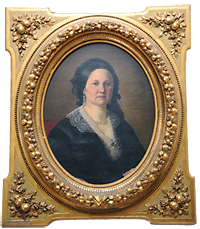 According to an old understanding that marriage is, after all, a good and healthy business, her custodian Hadži Kira married her when she was nearly 16, to a much older headman in his company Jovan Trandafil, born in Brašovo. According to an old understanding that marriage is, after all, a good and healthy business, her custodian Hadži Kira married her when she was nearly 16, to a much older headman in his company Jovan Trandafil, born in Brašovo.
The wedding was held in Oseka, on January 31, 1831, without much fuss and expenses, in an Orthodox church dedicated to Apostles Peter and Paul!
In the Thirty years of pleasant and unpleasant memories 1854 – 1884, Luka Jocić, later manager of the entire property Marija Trandafil had at that time, described the event with these words: ”They didn’t even ask her!”
The big capital Marija brought to the marriage as a dowry was used as a foundation for successful trading businesses which her husband Jovan, with the help of Hadži Kira Nikolić, led for the following years. In 1832, Jovan Tarndafil paid taxam concivlitatis and became the citizen of Novi Sad. That way he was able to trade textile and Erdelj cloth there, and make a fortune quite quickly. He invested it in real estate.
However, money and power didn’t bring the spouses good luck. Their children died one after another, first the daughter Sofija and then the son Kosta. Since then, the accidents were coming up one after another.
Novi Sad had an important role at the beginning of the national leavening in the Kingdom of Hungary and the Rebellion of 1848 led by Lajoš Košut, who was advocating economical and territorial independence of Hungary from the united Austrian empire, as well as recognizing Hungarians as the only nation there.
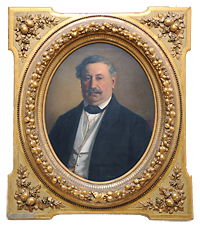 A bloody war broke out at the territory of today’s Vojvodina between Hungarians and Serbs, who supported the legal monarchy. The war especially hurt Novi Sad, which was bombed from the Petrovaradin fortress and destroyed by the Hungarian army. The city lost most of its population. From over 2.800 buildings and houses, barely 800 were left. Even today it is possible to see in the downtown, in the famous Dunavska Street, iron cannonballs trapped in facades, as a testimony of those events. A bloody war broke out at the territory of today’s Vojvodina between Hungarians and Serbs, who supported the legal monarchy. The war especially hurt Novi Sad, which was bombed from the Petrovaradin fortress and destroyed by the Hungarian army. The city lost most of its population. From over 2.800 buildings and houses, barely 800 were left. Even today it is possible to see in the downtown, in the famous Dunavska Street, iron cannonballs trapped in facades, as a testimony of those events.
Where the Trandafils were during the Hungarian rebellion is not well known. However, it is known that during the bombing, two of their houses at the market were burned down, so Jovan Trandafil took a loan of 30.000 forints in 1851/52 and used them as a flywheel for his trade.
In his book Famous Serbs of the XIX Century, Andra Gavrilović states the following words of Marija, concerning the bombing of Novi Sad:
”I have been poor for one day in my life and it was in 1849 when we were escaping a fire and had to starve in front of closed gates in Varadin, because we had no money to buy food to eat. When I remember that day, I feel what hunger and poverty are and that is why I do good deeds and help the poor.”
LED HER OWN NATIONAL POLITICS
 Marija thought her wealth was a hard burden and a temptation. After the death of Jovan in 1862, she had four lawsuits, including a case with her own brother Marko Popović. She and Jovan’s relatives, unsatisfied by the joint will of the spouses written in 1860, thought that Marija is, being a woman, unable to handle her own possessions. The lawsuits were tough and full of ”low blows”, but she managed to keep control over the entire capital. Marija thought her wealth was a hard burden and a temptation. After the death of Jovan in 1862, she had four lawsuits, including a case with her own brother Marko Popović. She and Jovan’s relatives, unsatisfied by the joint will of the spouses written in 1860, thought that Marija is, being a woman, unable to handle her own possessions. The lawsuits were tough and full of ”low blows”, but she managed to keep control over the entire capital.
Luka Jocić wrote down in his Memories... that Marija often spoke:
”I wish my children were alive, even if I had to live in greatest poetry. I would be happier and more joyful than I am with this dead treasure, which will nevertheless be left to some strangers.”
Immersed in her misfortune, she was looking for salvation in work, so she had been earning and multiplying her wealth for twenty years, while people were being disgusted by her ”unwomanly vocation”, which she had been doing even better than her male colleagues.
Having learned how to do business wisely, she was giving her wealth away to charity: by feeding, educating and taking care of the poor, thus providing physical survival of Serbian children during uncertain times and by building important edifices, which would later become places for important national institutions, such as Matica Srpska.
Mrs. Marija Tarndafil led her own national politics and her farsightedness wasn’t understood by the Serbs for a long time, not even today! The Trandafil spouses left a large part of their property to charity in the will written in Oseka on June 24, 1860. After  copy.jpg) the death of her husband and having multiplied her wealth a couple of times, Marija made new legacies, thus changing the basis of the former will, which lead to new differences amongst cousins. the death of her husband and having multiplied her wealth a couple of times, Marija made new legacies, thus changing the basis of the former will, which lead to new differences amongst cousins.
In the testament written in Novi Sad, on September 9, 1878 according to Roman calendar, as a reason for changing the will it is stated:
”From the day the common will was made until today, the times have changed and the needs of the Serbian people became different.”
The will ordered that 476 acres of land are to be used for beginning a fund for educating poor and gifted students, under the condition that ”...the children must be Eastern Orthodox Christians, but without any ethnical differences.”
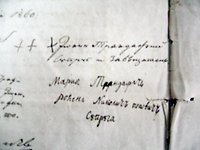 Thirty scholarships were given to students of Great Serbian Gymnasium in Novi Sad, today the ”Jovan Jovanović Zmaj” Gymnasium. Marija was deeply aware of the need to educate young Serbs, so they could rise above the subordinate position in the Austro-Hungarian society and state and thus become the new cultural elite of their people. Thirty scholarships were given to students of Great Serbian Gymnasium in Novi Sad, today the ”Jovan Jovanović Zmaj” Gymnasium. Marija was deeply aware of the need to educate young Serbs, so they could rise above the subordinate position in the Austro-Hungarian society and state and thus become the new cultural elite of their people.
Further in the will it literally says:
”House at the market, where Mr. Vajs’ store is at the moment, is left to the Cathedral Church in Novi Sad. The income from one house in Lebarska Street, where Mr. Jasnić lives, is to be used for marrying two poor Orthodox girls every year. The income from the second house in Lebarska Street, ‘at Sremac’, is left to be equally divided for poor widows and three poor men, merchants or craftsmen. The income from the house in Oseka goes to three hospitals, those in Novi Sad, Osečak and Sombor, equally divided…”
FOR ORTHODOX ORPHANS
Her biggest endowment is ”The endowment of Marija Trandafil for Serbian Orthodox orphans” in Novi Sad. She has authorized Matica Srpska to build her behalf a big and a beautiful building where boy orphans would stay. According to the will, the building of that endowment should have begun when the capital invested in the fund has risen to 300.000 forints. Only in 1908, the design of a Novi Sad architect Momčilo Tapavica was chosen. The president of Matica Srpska, Antonije Hadžić, gave his signature and verified the project. The costs of building rose from the initial calculation of 397.000 forints to half a million forints. The representative building, built in pseudo-classicist style, was completed in 1912. It grew at the corner of Han lot. Matica Srpska moved into this building in 1926, readjusting the interior to best suit their needs.
To suit the wishes of Marija Trandafil and with the consent of city authorities, it has been decided that a new building should be built for the needs of the orphanage. On the 30 acres property of the endowment at Sajlovo, a complex of buildings was constructed including a house for the accommodation of children, economy building and the apartment of the manager. The design was signed by Milivoj Matić and in 1930 the first twelve children moved in.
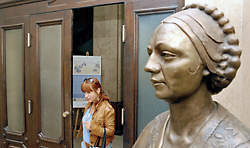 The children from the orphanage had to be educated in so-called industrial schools, or they went to ”German craftsmanship”, which were very rare among Serbs then. Every student was given 500 forints after finishing school to start their own business. The children from the orphanage had to be educated in so-called industrial schools, or they went to ”German craftsmanship”, which were very rare among Serbs then. Every student was given 500 forints after finishing school to start their own business.
According to the will, the Fund for material help of Nikolajevska and Uspenska church was founded. A third of the income from the house in Oseka was given to ”Uboški dom”, which was in the port of Nikolajevska church and for the needs of that church the ”The house at the icon” was given, located then in Ćurčijska Street, now Pašićeva 11, and 80 acres of best quality ground. The Fund of Nikolajevska church supported a priest, sacristan and one singer and if the priest’s wife would be left a widow, she had the right to lifelong income of 200 forints per year.
Upon Marija’s orders, the grand iconostasis of the Uspenska church was renewed, as well as the marble cross which has been beautifying the Novi Sad downtown for a long time, until it was moved to the yard of the Cathedral church.
She was deeply connected to the Nikolajevska church because her dearest ones were resting in the crypt of the same church. At the end of her life, alone, desperate and wearing nothing but black, she would often spend hours trying to recognize her children’s voice in the sound of the church’s bells. One day, she received a scandalous letter with the following content:
”The Serbian Orthodox church municipality of Novi Sad has noticed that you manage the Nikolajevska church by yourself and without any questions or permissions… This municipality is thereby obligated to announce that this must not and will not be tolerated anymore and so, as from today, the key of the above-mentioned church is taken from your hands.”
Deeply hurt by what people from the board have done, amongst which some of her students, Marija returned the keys of the church. She never laid foot in the churchyard for the rest of her life. Appalled by the treatment of the church municipality, the notable residents, Orthodox Serbians and mothers protested and sent a harsh petition with 100 signatures.
After the death of Marija Tarndafil, on October 14, 1883, the value of her immobile endowments and large family jewelry was 700.000 forints, which makes her the biggest endower amongst Serbs.
Marija Tarndafil is buried in the crypt of the Nikolajevska church, next to her children and husband.
It has been long since her last commemoration service was held.
***
Half of the City
Many residents of Novi Sad today do not know that houses in Zmaj Jovina Street 8, 16 and 17, Pašićeva 11, Dunavska 16 and Miletićeva 17 were actually property, and later endowment of Marija Trandafil. Very little is known about the destiny of these goods or about who owns them now.
***
Intrigues
At a celebration of leisured townspeople, angry acquisitive cousins spread stories about the alleged existence of compromising letters, which Marija had been writing to a certain gentleman of suspicious reputation. This kind of gossip has later become the favorite way of the Novi Sad provincials to treat extraordinary women in the city. Only twenty years later, Miša Dimitrijević was shot to death by Jaša Tomić because of an identical intrigue he knitted around Milica Tomić, born Miletić.
***
Salvation
During the great starvation, after the Rebellion in 1848, she fed all of the poorest people of Novi Sad for six weeks, regardless of religion, which was unusual at the time because every national or religious community took care of their own poor. She has worked according to her own conviction and according to her deep need for giving in the name of God and for the salvation of the soul, her and her dearest ones.
|
